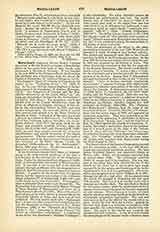

Mardin, a residential Armenian archbishopric, a Chaldean bishopric, and a residential Syrian bishopric; moreover it is the headquarters of the Capuchin mission of Mardin and Amida.
The ancient Syriac name was Marda, which meant fortress. It is mentioned as early as the time of Emperor Constantius (Amm. Marcell. xix, 9, 4) and again in the year 506 (Theophanis, “Chronogr.” A.M., 5998). The town became Christian under Tiridates II, King of Armenia, at the close of the third century, and it is probable that the churches, mausoleums, and houses, the ruins of which have been discovered, belong to this period. It played an important part in the religious controversies between the Catholics and Monophysites, who made it one of their principal monasteries. It had a Jacobite bishop in 684 (see the list of Syrian titulars, in Lequien, “Oriens Christ.,” II, 1454-1462; also “Revue de l’Orient Chretien”, VI, 200; also the list of Chaldean titulars given in Lequien, op. cit.. II, 1321). After 1166 the Jacobite patriarch, who had hitherto resided at Diarbekir, took up his residence in Mardia. During the Middle Ages, thanks to its strong position, the town escaped the attacks of Houlagon, grandson of Genghis Khan, and of Tamerlane. Since 1574 it has belonged to the Ottoman Empire, and is a sanjak in the vilayet of Diarbekir. It is situated at about 3600 feet above sea level, on a rugged browed and impregnable green hill; the grassy plain in the valley below is known as the Sea of Mardin. The population is computed at 25,000, of whom 15,500 are Mussulmans, the remainder being Christians. The number of Catholics of various rites is about 3000. In the Armenian archdiocese there are 8000 faithful, 16 native priests, 8 churches or chapels, 5 central stations, and 10 chapels of ease. The Syrian Catholic diocese has existed since 1852, and its title has been joined with that of Amida since 1888. The patriarch ought to reside at Mardin, but for some years past he has preferred Beirut on account of facility of communication with Europe. In the Syrian diocese there are 3500 Catholics, 25 priests, 8 churches and chapels, 11 stations, and the monastery of St. Ephraim. The Chaldean diocese, which is limited to the town of Mardin, has 750 faithful, 4 native priests, 1 parish, and 3 stations. The Capuchin mission dates from the seventeenth century, but its headquarters have been changed many times. It consists of 15 religious, of whom 11 are priests, and it has 6 houses (Diarbekir or Amida, Orfa or Edessa, Malatea or Melitene, Kharpout, Mamouret-ul-Aziz or Mozera, and Mardin). The mission owns 6 churches and 5 chapels; it carries on 18 primary schools, a college at Mamouret-ul-Aziz, 2 orphanages. The Franciscan Sisters of Lons-le-Saunier have three establishments for girls, one at Diarbekir, one at Orfa, and one at Mardin. The superior of the mission is Rev. J. Antonius a Mediolano, O.M.C. There is moreover a schismatic Armenian archbishop in the town, and an American Protestant mission is in activity.
S. VAILHE

